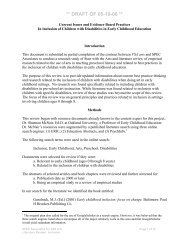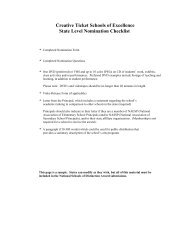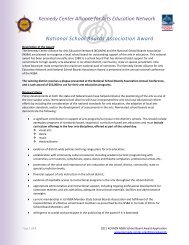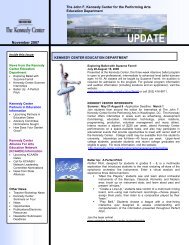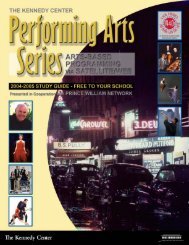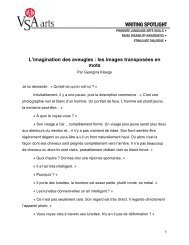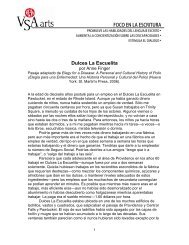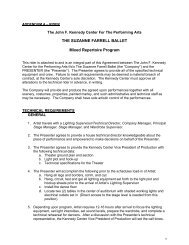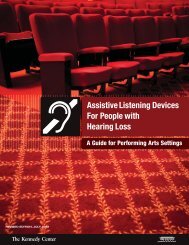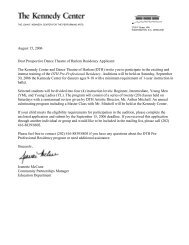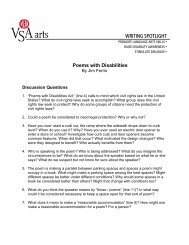Playwright Discovery Award Teacher's Guide - The John F. Kennedy ...
Playwright Discovery Award Teacher's Guide - The John F. Kennedy ...
Playwright Discovery Award Teacher's Guide - The John F. Kennedy ...
Create successful ePaper yourself
Turn your PDF publications into a flip-book with our unique Google optimized e-Paper software.
FOR THE ARTIST’S NOTEBOOK:<br />
<strong>The</strong> Elements of Dramatic Form<br />
A<br />
play has basic elements that inform the<br />
flow of dramatic action and the form the<br />
play takes.<br />
Plot<br />
<strong>The</strong> specific events that build a story. A play’s<br />
plot can be summarized in a single, active<br />
sentence. An active sentence has one or two<br />
verbs and few words that qualify and explain<br />
the story. For example: A boy meets a girl and<br />
tries to date her.<br />
Story<br />
How the plot unfolds. It often explains the<br />
circumstances that influence the plot. This<br />
would include descriptions of how the date<br />
came to be and how the boy and girl meet.<br />
An Inciting Incident<br />
<strong>The</strong> trigger that sets the story and conflict<br />
in motion<br />
A Series of Conflicts<br />
<strong>The</strong> obstacles the characters encounter<br />
and deal with. <strong>The</strong>y either succeed or<br />
fail. Remember, failures reveal more than<br />
successes.<br />
A Secret or Problem<br />
A hidden truth the characters hide from one<br />
another or seek to uncover. Think of this as the<br />
mysteries within the story.<br />
Characters Who Learn and Change<br />
If characters know everything from the first<br />
page, they aren’t very interesting. If we see<br />
them learn new things, discover truths about<br />
themselves or others, and watch them use that<br />
information to alter how they act or behave,<br />
the play will be strong and keep our interest.<br />
A Crisis or Conflict Moment<br />
<strong>The</strong>se are mini crises or obstacles. Sometimes<br />
the characters can solve the problems simply<br />
or avoid them until the major conflict or crisis<br />
moment.<br />
Conflict, the struggle of characters overcoming<br />
obstacles, creates the friction needed to create<br />
dramatic interest and action.<br />
Character v Character<br />
An example of Character v Character conflict<br />
is: One character wants to leave a room and<br />
another character stands in the way or says<br />
something that stops the other character from<br />
leaving.<br />
Character v Situation<br />
An example of Character v Situation conflict<br />
is: One character wants to leave the room but<br />
there is no visible door.<br />
<strong>The</strong> Climactic Moment<br />
<strong>The</strong> point of no return. This is the moment<br />
where every character’s secret, need, and<br />
problem come together. When this moment<br />
ends, no one is the same. <strong>The</strong> play often ends<br />
very soon after this dramatic event.<br />
ACT III: DRAMATURGY 41



